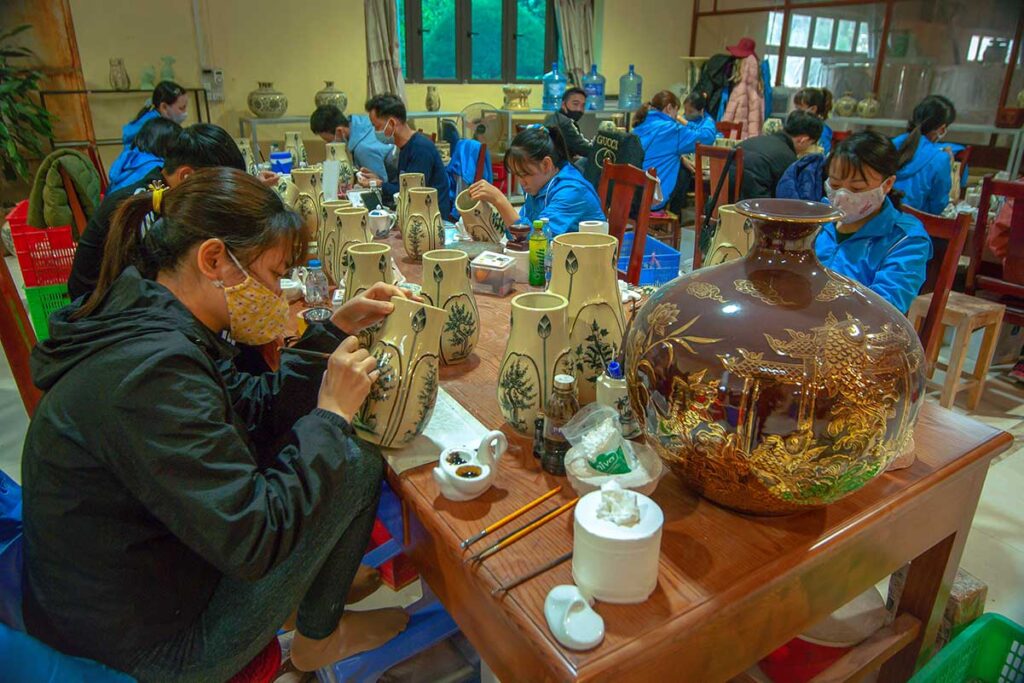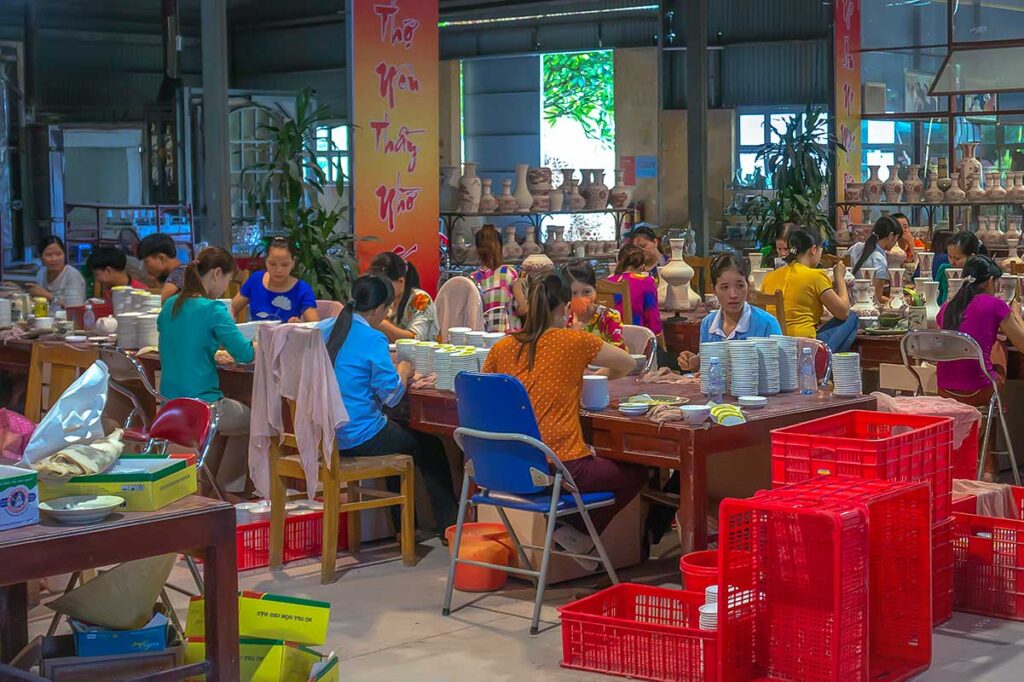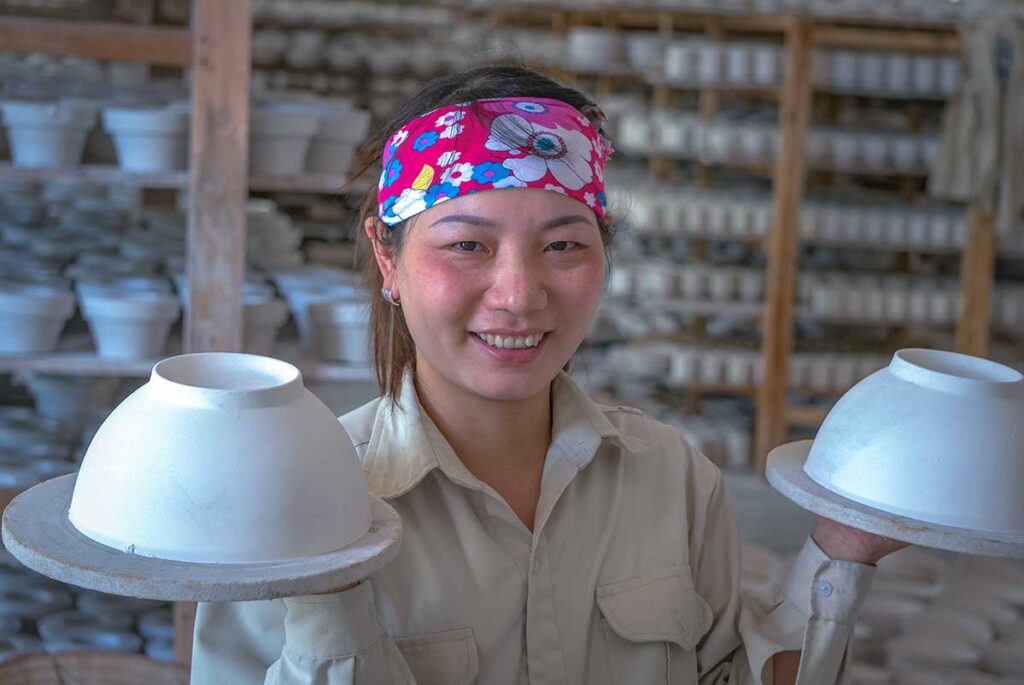The history of Chu Dau Ceramic Village
Early Origins and Golden Age
Chu Dau’s ceramic tradition began between the 12th and 14th centuries, reaching its peak in the 15th to 17th centuries during a flourishing period of Vietnamese trade. Artisans in this small Hai Duong village produced elegant, hand-painted ceramics that were exported across Asia and Europe via the ancient maritime Silk Road. Some of these pieces have been recovered from shipwrecks, while others remain in museum collections around the world.
Style and Symbolism
Chu Dau pottery stood out for its ivory-white base, deep blue glaze, and delicate hand-painted motifs. Common themes included lotuses, cranes, and village scenes—reflecting influences from Buddhism, Confucianism, and local Vietnamese life. These ceramics were not only decorative but also seen as cultural expressions of the era’s values and identity.
Decline and Rediscovery
By the late 17th century, the pottery tradition in Chu Dau faded away and was eventually forgotten. Its revival began in the 1980s, when Vietnamese historians identified a blue-and-white vase in Istanbul’s Topkapi Saray Museum. The piece was signed by Bui Thi Hy, a female artisan from Chu Dau, and became a key symbol in reconnecting the village to its lost heritage.
Modern Restoration Efforts
In 2001, the Hanoi Trade Corporation (Hapro), now part of the BRG Group, established the Chu Dau Ceramics Joint Stock Company to restore the village’s craft. They reconstructed kilns, trained new artisans, and revived traditional designs using archaeological findings. Today, the village produces both replicas of ancient works and new ceramic lines adapted for modern use.

A Cultural Symbol with Global Reach
Chu Dau ceramics are now exported to over 30 countries and used in high-end Vietnamese hotels, restaurants, and cultural spaces. Beyond their function as decorative or household items, they serve as a symbol of national pride—representing centuries of craftsmanship, spiritual depth, and artistic skill passed down through generations.

Things to See and Do in Chu Dau today
While Chu Dau Pottery Village is mainly known for its ceramics, there are a few places you can explore during a visit. The experience is more about quiet appreciation than hands-on interaction, and most stops are within walking distance from one another.
1. Chu Dau Pottery Showroom & Exhibition Hall


The main attraction is the large 1,000 m² showroom and exhibition hall operated by Chu Dau Ceramics Joint Stock Company. Here you’ll find an extensive collection of pottery ranging from household items to spiritual and decorative pieces. Most follow traditional designs, with common motifs like lotus flowers, cranes, village scenes, or ancient symbols representing harmony and Vietnamese philosophy.
You can browse or shop directly, and the space is set up for visitors, though signage in English may be limited. Prices range from affordable souvenirs to high-end pieces.
2. Walking around the village
Chu Dau has a quiet, traditional feel, but it isn’t a scenic village in the way that some craft villages are curated for tourism. There’s no central square, and most of the village consists of residential homes, small pottery workshops, and production areas. It’s interesting for those curious about local life, but don’t expect a postcard-perfect setting or well-developed tourist paths.
3. Ancient Kiln Sites (Limited Access)
Some restored kilns are located near the exhibition area, offering a glimpse into how pottery was fired centuries ago. However, they are not always open to the public, and information is limited unless you’re part of an arranged group visit. If you go independently, you might only be able to view them from the outside.
4. Local Pagoda: Phuc Khanh

Phuc Khanh Pagoda is a small, peaceful temple near the village. It has a simple design and a quiet atmosphere, offering a short but pleasant stop if you’re already in the area. It’s not a major sightseeing destination, but it adds a bit of cultural context to your visit.
5. Communal House of Chu Dau

The village’s communal house (đình) reflects traditional Vietnamese architecture and holds cultural significance for local residents. It’s used for worship and festivals and has connections to the craft’s historical development. While modest in size, it adds to the picture of Chu Dau’s heritage.
6. Pottery Workshops (Limited Availability)
There is little information confirming regular, visitor-friendly pottery workshops in Chu Dau. While it’s possible that activities may be arranged through the showroom or for pre-booked groups, this isn’t guaranteed. Unlike Bat Trang, where pottery-making experiences are widely available, Chu Dau is less commercial and not set up for casual walk-in sessions. If hands-on activities are important to you, it’s best to confirm in advance—or consider visiting Bat Trang instead.

How to get to Chu Dau Pottery Village
Chu Dau Pottery Village is located in Thai Tan Commune, Nam Sach District, Hai Duong Province—about 90 minutes by car from Hanoi. There’s no direct public transport to the village itself, so you’ll need to arrange your own transport. Below are the two most practical options for getting there.
Private car with driver
The easiest and most comfortable way to visit Chu Dau is by hiring a private car with driver for a half- or full-day trip. This typically comes with a fixed price that includes round-trip transport and waiting time while you explore the village. It’s also the most flexible option if you want to combine Chu Dau with nearby sights like Con Son Pagoda or a water puppet village.
Keep in mind that drivers in Vietnam are not tour guides. They can take you there and wait, but they won’t explain the history or walk around with you.
Motorbike (Self-drive)
Driving a motorbike to Chu Dau is possible, but only recommended for confident riders with experience navigating Vietnamese highways. The route includes long stretches of highway and local roads with limited signage. There isn’t much to stop for along the way, so the ride is mostly about getting to the destination.
If you choose this option, plan your fuel stops and bring offline maps or navigation support.
Nearby sights worth combining
While Chu Dau Pottery Village is quite remote, there are a few other places in Hai Duong Province that you can combine with your visit—especially if you’re traveling by private car. These stops are not major tourist attractions, but they offer cultural value and help make the trip more worthwhile.
Con Son – Kiep Bac Complex
Located about 45 minutes from Chu Dau, this historic complex includes temples, pagodas, and memorials tied to famous figures in Vietnamese history such as Nguyen Trai and Tran Hung Dao. There’s also a peaceful forest walk leading up to a viewpoint. Best visited with a driver so you can explore at your own pace.
➤ Link to full guide: Con Son – Kiep Bac Complex
Thanh Hai Water Puppet Village
Roughly 30 minutes from Chu Dau, this rural village is known for preserving traditional water puppetry—a uniquely Vietnamese art form. Performances are not held daily, so it’s important to check availability in advance. A good add-on for those interested in folk culture.
Thanh Ha Lychee Orchards
In the same area as the puppet village, these orchards are best visited during lychee season (May to June). It’s a scenic rural area with the chance to try fresh lychees, meet local farmers, and buy homemade products. Outside of the harvest season, there’s less to see.
➤ Link to full guide: Things to Do in Hai Duong
Is Chu Dau Pottery Village worth visiting?
If you’re deeply interested in Vietnamese ceramic heritage, then Chu Dau Pottery Village may be worth the journey. It offers cultural value, historical importance, and a glimpse into a lesser-known part of Vietnam’s artistic legacy.
That said, it’s not for everyone. The village has limited tourist infrastructure, and it’s not set up for interactive activities like pottery workshops. The setting is quiet and authentic, but not particularly scenic or walkable for casual visitors. Getting there also takes time—about 90 minutes each way from Hanoi—and there aren’t many major attractions nearby.
Unless you’re combining it with other regional sights or you’re specifically interested in antique ceramics, it can be hard to justify the trip as a standalone day tour. If you’re short on time or looking for a more hands-on experience, a pottery village like Bat Trang may be a better fit.



